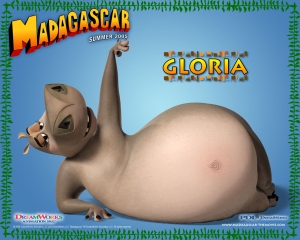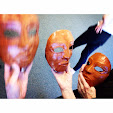
"Which was your favorite character?" My daughter asked me of the film Madagascar, which we saw today. Huh. A favorite. Well, there was basically one female character, a hippopatamus whose job as a character was to support the friendship of the male leads, a lion and a zebra. The zebra's conflict was that he needed some adventure and the lion's conflict was that he was hungry. At the risk of sounding like a humorless feminist, which I often am, I'm just a wee bit bored-to-death with male leads, their male sidekicks, and the females who get a corner of the screen to use staring at the dudes.
My son had been counting down the days until the opening of Madagascar. We had arranged to see it with a friend my children, his mother and his three-year-old brother. Much excitement leading up to it.
My spirits sank as I noticed, while checking showtimes and arranging to meet our friends, the PG rating "for crude humor." "Uh oh," I said into the phone to the other mother without thinking. "Here come the fart jokes. Or worse, if the script is really bad." When I hung up I turned to my son, who had tears in his eyes.
"I'm not going," he said with a choked voice. He really hates "juvenile humor," the provenance of adults with creative limitations who somehow managed, when history named this branch of comedy, to get juveniles blamed for things vulgar. For an hour he argued for staying home. "I won't like it."
"Look," I said. "There are websites for parents where they detail all the things about a movie that might be a problem for parents or kids. I can go read one of their reviews."
"I don't want to know what the problems are."
"That's ok, I'll read and report back to you without the details."
So I read the review on Kids-in-Mind, a site with a numbered rating system for sex and nudity, violence and gore, and profanity that intends to "enable concerned adults to determine whether a film is appropriate for them and their children according to their own criteria and values."
From their review it sounded like Madagascar would have the usual male-dominated cast, with one female in a principal role, the cliché mild-elder-woman-who-beats-up-a-ferocious animal...and we wouldn't be getting away without a fart joke or two. The only value of mine it seemed to support was that the giraffe gets an acupuncture treatment. All right!
And there would be some "name-calling," Kids-in-Mind noted, including "pansies."
The "profanity glossary" on the site says "Words or expressions that are used to denigrate and insult one's racial or ethnic background, gender or sexual orientation: Examples include the N-word, various anti-Semitic terms, and anti-homosexual terms like fa**ot."
In my book, "pansies" is anti-homosexual, so I wrote and told them so (nonsensically, it's also pejorative for "nonviolent").
To my surprise Kids-In-Mind wrote right back, said 'right you are,' and changed their designation of pansies to "derogatory." Which is why I'm plugging their site, which has been helpful to me on other occasions with the Highly Sensitive Viewers at my house. (Who until today, by the way, had never said "that sucks." Thank you so very much, whoever thinks a kid's movie can't do well without a PG rating.)
Hollywood should have purged itself of the anti-gay thing long ago, so why does it persist? And, aside from: 1) the occasionally-enlightened Pixar, which throws girls crumbs like Dory (Finding Nemo) and Jessie (Toy Story 2) and 2) the women's liberaton allegory Chicken Run, which in any case had to cross the Atlantic to be screened in the land where women's suffrage was first won (1869, in Wyoming Territory), why are female cartoon personalities nearly always one-dimensional, often ruled by sex jokes or shunted to the side?
If a female buddy movie starred a zebra and a lion, would they have to drive themselves off a cliff at the end so audiences wouldn't be too threatened by the awesome power of female buddyship? Please!


No comments:
Post a Comment